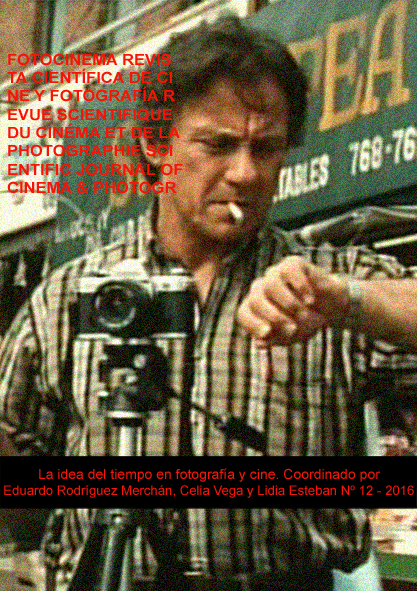Tiempo y narratividad en la fotografía: de la paradoja al campo expandido
DOI:
https://doi.org/10.24310/Fotocinema.2016.v0i12.6036Abstract
El análisis de las relaciones entre tiempo y narratividad en la fotografía toma como punto de partida la paradoja entre instantánea y posado, tal como ha sido planteada por Thierry de Duve. De modo correlativo las nociones de estasis y narratividad se relacionan con los términos de la paradoja a partir del tiempo fenomenológico de la experiencia perceptiva y de las cualidades estéticas inherentes a la imagen fotográfica. Sin embargo, el paradigma formalista en el que se enmarca dicho análisis restringe las posibilidades narrativas de la fotografía. Los debates posmodernos en torno a la fotografía que tuvieron lugar en las dos últimas décadas del siglo XX enfocaron una nueva perspectiva para la comprensión narrativa del la imagen sobre la base de la intermedialidad. En este contexto, el concepto de campo expandido de la fotografía se propone como clave conceptual que incorpora, a los anteriores procesos de hibridación medial, las relaciones de la fotografía con el cine así como el impacto de lo digital sobre lo fotográfico para dar cabida a una comprensión cinemática de la fotografía.
Abstract:
The analysis of the relationship between time and narrativity in photography takes as point of departure the photographic paradox between snapshot and time exposure, as it has been raised by Thierry de Duve. Notions of stasis and narrativity are related to the terms of the paradox from the phenomenological time of perceptual experience and the aesthetic qualities inherent in the photographic image. However, the formalist paradigm that is part of this analysis restricts the narrative possibilities of photography. Postmodern debates around photography that took place in the last two dacadas of the 20th century focused a new perspective for understanding narrative of the image based on the intermediality. In this context, the concept of expanded field of photography is proposed as a conceptual key that incorporates previous medial hybridization processes, relations of photography with film as well as the impact of digital on the photographic to accommodate a cinematic photography understanding.
Palabras clave:
Fotografía; paradoja; estasis; narratividad; tiempo.
Keywords:
Photography; Paradox; Stasis; Narrativity; TimeDownloads
Metrics
Downloads
Published
How to Cite
Issue
Section
License
All contents published in Fotocinema Revista científica de cine y fotografía are protected under the Creative Commons Attribution-NonCommercial-ShareAlike 4.0 International (CC BY-NC-SA 4.0) license. All about this license is available in the following link: <http://creativecommons.org/licenses/by-nc-sa/4.0>
Users can copy, use, redistribute, share and exhibit publicly as long as:
- The original source and authorship of the material are cited (Journal, Publisher and URL of the work).
- It is not used for comercial purposes.
- The existence of the license and its especifications are mentioned.
There are two sets of authors’ rights: moral and property rights. Moral rights are perpetual prerogatives, unrenounceable, not-transferable, unalienable, imprescriptible and inembargable. According to authors’ rights legislation, Fotocinema. Revista científica de cine y fotografía recognizes and respects authors moral rights, as well as the ownership of property rights, which will be transferred to University of Malaga in open access. The property rights are referred to the benefits that are gained by the use or the dissemination of works. Fotocinema. Revista científica de cine y fotografía is published in an open access form and it is exclusively licenced by any means for doing or authorising distribution, dissemination, reproduction, , adaptation, translation or arrangement of works.
Authors are responsable for obtaining the necessary permission to use copyrighted images.













13.png)




